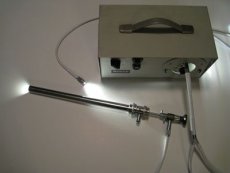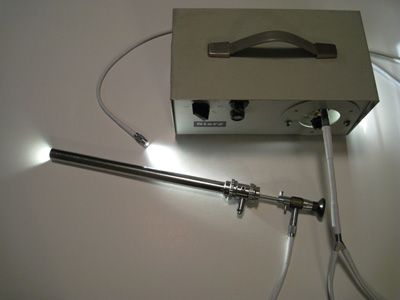Medical expert of the article
New publications
Rectoromanoscopy
Last reviewed: 03.07.2025

All iLive content is medically reviewed or fact checked to ensure as much factual accuracy as possible.
We have strict sourcing guidelines and only link to reputable media sites, academic research institutions and, whenever possible, medically peer reviewed studies. Note that the numbers in parentheses ([1], [2], etc.) are clickable links to these studies.
If you feel that any of our content is inaccurate, out-of-date, or otherwise questionable, please select it and press Ctrl + Enter.

Rectosigmoidoscopy is the main method of visual examination of the rectum and distal sigmoid colon. It studies the condition of the mucous membrane over a 30 cm section. In recent years, the rigid rectoscope has been replaced by flexible fiberglass sigmoidoscopes, which make it possible to examine the entire left colon, the most common location of tumors. In some cases, using special techniques, a sigmoidoscope can examine not only the left colon, but the entire colon, but for these purposes, colonoscopes 140-150 cm long are more convenient (the length of a sigmoidoscope is 90 cm).
This method is also called sigmoidoscopy, since the sigmoid colon is also involved in the examination. In order to make a correct diagnosis of a person with azaporosis, it is necessary to examine the condition of the rectum. How is it located, are there any defects or lesions in it? Do all parts of the rectum function normally? Technical devices during rectoscopy will help to do this correctly.
What is a rectoscopy or sigmoidoscopy?
This is an accessible and very informative method of diagnosing the rectal lining, which is used when examining patients with constipation. The name comes from the Latin word rectus, which means straight. Previously, this was the name of the sigmoid colon, which gave another, now obsolete name to the method - sigmoidoscopy.
What does this diagnostic method mean? It means that the doctor will be able to examine the mucous membrane and the sigmoid colon (the part adjacent to the rectum) using a special device - a rectoscope. It is inserted into the anus and rectum.
What is a rectoscope?

This is a metal tube that is 15 to 35 cm long and has a diameter of just over one centimeter. The end of the tube is unusual - a special device with a light source is connected to it - an eyepiece, through which you can see everything that is happening in the anus. A pump is also connected to this device, which pumps air into the rectum. This pump is made in the form of a special double cylinder.
Is sigmoidoscopy safe?
Both doctors and patients claim that yes, this is a safe method. In addition, it is completely painless for health. And it allows for excellent research, revealing what is really going on in the rectum. This method is used in an outpatient setting and does not require time spent in a hospital. Also, doctors will skillfully conduct the rectoscopy method in a diagnostic center or a specialized clinic.
How is a rectoscopy performed?
The patient is placed on a special table or couch and assumes a knee-elbow position. Then the doctor lubricates the end of the tube with Vaseline, puts on rubber gloves and inserts this rectoscope tube into the rectum. To straighten the walls of the rectum for better viewing, a little air is pumped into the rectum using a double pump.
The doctor carefully advances the tube into the rectum and simultaneously examines its condition, especially the mucous membrane. This condition of the rectum is displayed on a screen connected to the rectoscope.
What is revealed during retromanoscopy?
During this diagnostic examination method, the condition of the rectal mucosa is determined, whether there are cracks or wounds in it. Whether there is blood, purulent deposits, or mucus in the rectum, whether the rectum is narrowed, whether there are tumors or inflammation in it. And whether polyps are found.
If pathological changes are detected in the rectum using the retromanoscopy method, it will be easier to combat constipation and hemorrhoids. By the way, about hemorrhoids - with the help of this method, it is possible to detect inflammation and enlargement of the cavernous bodies, which are located in the rectum and look like grapes.
Then it will be possible to detect hemorrhoids at their initial stage and deal with this disease faster. The doctor will be able to easily determine the size of the "grapes" - inflamed cavernous bodies, and also find out if there are signs of thrombosis and inflammatory processes in the rectum.
The retromanoscopy method can also detect the condition of the tissues by taking samples using scraping. And then it will be possible to diagnose malignant tumors in the rectum. Their detection will help to start treating these tumors at early stages, which is more successful than with advanced forms of cancer.
Why is retromanoscopy so good?
At Oxford University, retromanoscopy is preferred as a very safe procedure for several reasons.
Retromanoscopy is the best way to diagnose colon cancer, the second most common cause of cancer death in the United States.
This procedure can also be used to help investigate rectal problems such as bleeding, abdominal pain, diarrhea or constipation.
At least three conclusions can be drawn from this procedure.
- You are healthy and no other tests are needed (Although retromanoscopy is the most important tool in evaluating colon cancer, a very small percentage of people with normal retromanoscopy findings are later found to have cancer).
- A detailed diagnosis of your specific disease is made.
- The patient may require additional testing, counseling, therapy, or follow-up diagnostics.
Several leading medical groups recommend routine screening of men and women aged 50 and older for colon cancer and benign (harmless) polyps every 3 to 5 years using retromanoscopy.
Younger patients may not have this procedure as often unless they have close relatives with colon cancer.
A screening procedure similar to retromanoscopy is known as a colonoscopy. The main difference is that in a colonoscopy the tube goes further up the colon than in a retromanoscopy.


 [
[